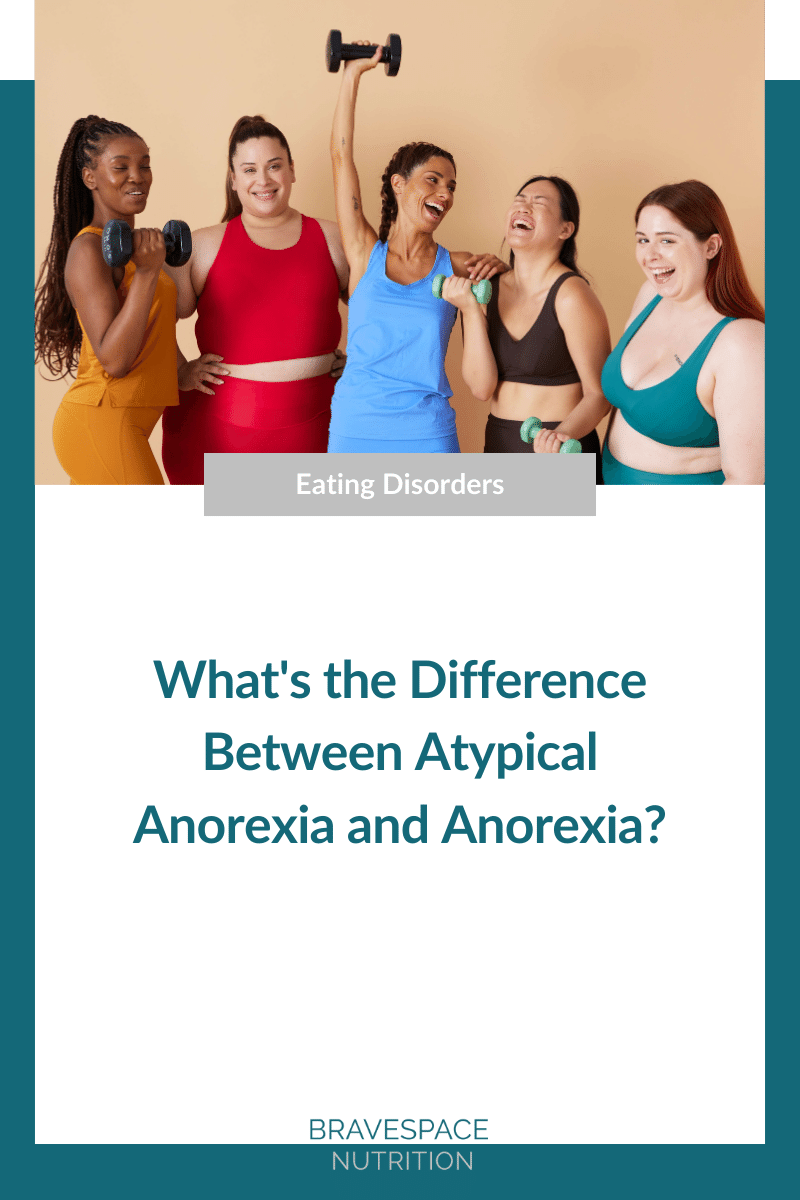What's the Difference Between Atypical Anorexia and Anorexia?
Atypical anorexia isn’t atypical at all. In fact, the prevalence of this diagnosis by age 20 is 28% for atypical anorexia and less than 1% for anorexia (1).
What is Atypical Anorexia Nervosa?
Atypical anorexia nervosa was recently added to the DSM-5 in 2013 under the category Other Specified Feeding or Eating Disorders (OSFED). By definition, atypical anorexia nervosa is “meeting all of the criteria of anorexia nervosa, except that despite significant weight loss, the individual’s weight is still considered normal or above normal [according to the BMI scale].” Those with atypical anorexia experience the same psychological and physical symptoms as those with anorexia; however, they remain at or above a “normal” body weight despite losing a significant amount of weight.
Signs and symptoms of atypical anorexia:
Those with atypical anorexia experience the same physical and psychological signs and symptoms as those with anorexia, like the following:
Physical signs and symptoms:
Significant weight loss
Abnormal blood counts
Fatigue
Insomnia
Dizziness or fainting
Brittle and/or thin hair
Soft downy hair covering the body (called lanugo)
Absence of a period (for those that experience a menstrual cycle)
Gastrointestinal issues and abdominal pain
Dry and/or yellowish skin
Intolerance of the cold
Low blood pressure
Psychological signs and symptoms:
Preoccupation and obsession with food
Frequently skipping meals or refusing to eat
Only eating a few select safe foods
Avoiding social situations that involve food and social withdrawal
Rigid food rituals and strict food rules
Intense fear of gaining weight and/or strong desire to lose weight
Denial of hunger cues
Frequent body-checking (checking appearance in reflective surfaces)
Irritability
Disinterest in sex and low libido
What are other differences between atypical anorexia and anorexia?
As mentioned earlier, those with atypical anorexia and anorexia experience similar signs and symptoms. The only difference is that individuals with atypical anorexia are considered at or above a “normal weight” according to body-mass-index (BMI). BMI is a simple measure that doesn’t accurately reflect the psychological and behavioral aspects of eating disorders. Relying solely on BMI to differentiate atypical anorexia and anorexia can be harmful and has negative impacts on anyone struggling with food and body image issues, and especially with anorexia.
5 Reasons Why Atypical Anorexia is a Harmful Diagnosis
1. Perpetuates weight stigma in healthcare
Atypical anorexia as a diagnosis perpetuates harmful misconceptions and stereotypes about eating disorders. Healthcare providers who aren’t familiar with eating disorders tend to trivialize or dismiss those with atypical anorexia. Practitioners are often taught that key indicators of anorexia are when the individual is severely emaciated and underweight. The truth is that the majority of people who struggle with anorexia aren’t underweight. People who are experiencing anorexia who are not underweight are often ignored or dismissed by their healthcare team (and sometimes told to lose weight and are put on a diet!) . This causes so much harm. Weight stigma in healthcare leads people to avoid seeking medical care, avoid treatment, and develop distrust in healthcare providers, all of which worsen the prognosis of an eating disorder.
2. Encourages further weight loss and engagement in disordered eating behaviors
People with atypical anorexia often internalize the belief that anorexia means you need to be underweight, and they believe that they need to fit the typical anorexia stereotype in order to get care, rightfully so. This diagnosis leads people to think…”If I’m not thin, I won’t be taken seriously.”
Essentially, this can cause individuals to believe that they aren’t “sick enough” and don’t have a problem that’s worthy of getting help for. For many, it can feel like a greenlight to keep engaging in disordered eating behaviors and not seek help.
This can also cause individuals to want to lose more weight so that they can be perceived as “sick enough” to be taken seriously by friends, family, and healthcare providers. Disordered eating behaviors often persist and worsen, which is dangerous for those struggling. There are many health risks associated with weight loss in those with atypical anorexia.
3. Invalidates individual experiences with food and body image.
People with atypical anorexia still struggle with the same preoccupations about food, weight, and body image as those with “typical” anorexia. Using the word “atypical” in the diagnosis can invalidate many of the experiences that those with anorexia have regarding food and body image. This invalidation can worsen emotional distress and makes it much more challenging to seek help.
4. Delays diagnosis of eating disorders and disordered eating
Healthcare providers are typically taught to look for low weights and emaciation for an anorexia diagnosis, but what happens if someone is struggling with anorexia and doesn’t appear to be underweight?
Many cases of atypical anorexia go underdiagnosed or are misdiagnosed because doctors focus on weight and ignore other symptoms of anorexia. They make assumptions about body size and assume binge eating is occurring, and therefore dieting and food restriction is an appropriate recommendation.
Doctors and other healthcare providers may not receive adequate training in recognizing and understanding presentations of eating disorders outside of mainstream perceptions of anorexia. Without the knowledge and skills to identify anorexia in people of all body types, they may overlook or misinterpret signs and symptoms of anorexia.
Atypical anorexia was only recently added to the DSM-5 in 2013. It’s not as widely recognized as it should be, and this worsens misdiagnosis and underdiagnosis.
5. Places too much emphasis on the physicalities of a psychological disorder
By categorizing eating disorders based on body weight, there is a risk of placing too much emphasis on the physicality of an eating disorder. Using weight as the primary indicator for severity of an eating disorder or condition is an attempt to simplify deeply complex issues. This overshadows the psychological and emotional aspects of anorexia and other eating disorders. Eating disorders exist in all size bodies and you can never know by looking at someone if that they an eating disorder and/or what kind of eating disorder they have.
References:
Vo M, Golden N. Medical complications and management of atypical anorexia nervosa. J Eat Disord. 2022 Dec 16;10(1):196. doi: 10.1186/s40337-022-00720-9. PMID: 36522787; PMCID: PMC9756584.
You’ll also love…
Are you struggling to navigate your diagnosis with atypical anorexia? Are you tired of feeling unseen and unheard in your battle with food, weight, and body image?
Bravespace Nutrition is here to make sure you feel seen and heard in your experiences. Our caring, non-judgmental dietitians work to help you heal your relationship with food while addressing the deep-root causes of your eating disorder. To get started today, schedule a free 15-minute discovery phone call!




